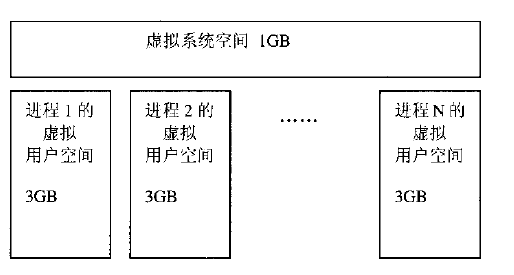linux混混之牢骚:
可怜的安阳的,你承担和温州一样的故事,却引不起老温的注意……悲哀啊,故乡。。。
2.1 linux内存管理基本框架
linux中的分段分页机制分三层,页目录(PGD),中间目录(PMD),页表(PT)。PT中的表项称为页表项(PTE)。注意英文缩写,在linux程序中函数变量的名字等都会和英文缩写相关。
LINUX中的三级映射流程如图:

但是arm结构的MMU在硬件只有2级映射,所以在软件上会跳过PMD表。即:在PGD中直接放的是PT的base address。在linux软件上就是:
#define PMD_SHIFT 21
#define PGDIR_SHIFT 21 //让PMD_SHIFT 和 PGDIR_SHIFT 相等就可以了。
新的2.6内核和内核源码情景分析上的差别挺大的,在2.6.11版本以后,linux将软件上的3级映射变成了4级映射,在PMD后面增加了一个PUD(page upper directory). 在arm的两级映射中,跳过PMD和PUD
在2.6.39内核arch/arm/include/asm/pgtable.h中有下代码:
/*
* Hardware-wise, we have a two level page table structure, where the first
* level has 4096 entries, and the second level has 256 entries. Each entry
* is one 32-bit word. Most of the bits in the second level entry are used
* by hardware, and there aren't any "accessed" and "dirty" bits.
*
* Linux on the other hand has a three level page table structure, which can
* be wrapped to fit a two level page table structure easily - using the PGD
* and PTE only. However, Linux also expects one "PTE" table per page, and
* at least a "dirty" bit.
*
* Therefore, we tweak the implementation slightly - we tell Linux that we
* have 2048 entries in the first level, each of which is 8 bytes (iow, two
* hardware pointers to the second level.) The second level contains two
* hardware PTE tables arranged contiguously, preceded by Linux versions
* which contain the state information Linux needs. We, therefore, end up
* with 512 entries in the "PTE" level.
*
* This leads to the page tables having the following layout:
*
* pgd pte
* | |
* +--------+
* | | +------------+ +0
* +- - - - + | Linux pt 0 |
* | | +------------+ +1024
* +--------+ +0 | Linux pt 1 |
* | |-----> +------------+ +2048
* +- - - - + +4 | h/w pt 0 |
* | |-----> +------------+ +3072
* +--------+ +8 | h/w pt 1 |
* | | +------------+ +4096
*
* See L_PTE_xxx below for definitions of bits in the "Linux pt", and
* PTE_xxx for definitions of bits appearing in the "h/w pt".
*
* PMD_xxx definitions refer to bits in the first level page table.
*
* The "dirty" bit is emulated by only granting hardware write permission
* iff the page is marked "writable" and "dirty" in the Linux PTE. This
* means that a write to a clean page will cause a permission fault, and
* the Linux MM layer will mark the page dirty via handle_pte_fault().
* For the hardware to notice the permission change, the TLB entry must
* be flushed, and ptep_set_access_flags() does that for us.
*
* The "accessed" or "young" bit is emulated by a similar method; we only
* allow accesses to the page if the "young" bit is set. Accesses to the
* page will cause a fault, and handle_pte_fault() will set the young bit
* for us as long as the page is marked present in the corresponding Linux
* PTE entry. Again, ptep_set_access_flags() will ensure that the TLB is
* up to date.
*
* However, when the "young" bit is cleared, we deny access to the page
* by clearing the hardware PTE. Currently Linux does not flush the TLB
* for us in this case, which means the TLB will retain the transation
* until either the TLB entry is evicted under pressure, or a context
* switch which changes the user space mapping occurs.
*/
#define PTRS_PER_PTE 512 //PTE的个数
#define PTRS_PER_PMD 1
#define PTRS_PER_PGD 2048
#define PTE_HWTABLE_PTRS (PTRS_PER_PTE)
#define PTE_HWTABLE_OFF (PTE_HWTABLE_PTRS * sizeof(pte_t))
#define PTE_HWTABLE_SIZE (PTRS_PER_PTE * sizeof(u32))
/*
* PMD_SHIFT determines the size of the area a second-level page table can map
* PGDIR_SHIFT determines what a third-level page table entry can map
*/
#define PMD_SHIFT 21
#define PGDIR_SHIFT 21 //另PMD和PDGIR相等,来跳过PMD。
/*linux将PGD为2k,每项为8个byte。(MMU中取值为前高12bit,为4k,每项4个byte,但linux为什么要这样做呢?) ,另外linux在定义pte时,定义了两个pte,一个供MMU使用,一个供linux使用,来用描述这个页。
*根据注释中的表图,我看到有 #define PTRS_PER_PTE 512 #define PTRS_PER_PGD 2048 , linux将PDG定义为2K,8byte,每个pte项为512,4byte。 他将 两个pte项进行了一下合并。为什么?为什么?
**/
在进程中,传说是可以看到4G的空间,按照linux的用户空间和内核空间划分。 其实进程可以看到3G的自己进程的空间,3G-4G的空间是内核空间,进程仅能通过系统调用进入。

2.2地址映射全过程
将x86的段地址,略。。。
2.3几个重要的数据结构和函数
PGD,PTE的值定义:
/*
* These are used to make use of C type-checking..
*/
typedef struct { pteval_t pte; } pte_t;
typedef struct { unsigned long pmd; } pmd_t;
typedef struct { unsigned long pgd[2]; } pgd_t; //定义一个[2]数组,这样就和上面的介绍对应起来了,每个







 最低0.47元/天 解锁文章
最低0.47元/天 解锁文章














 4231
4231











 被折叠的 条评论
为什么被折叠?
被折叠的 条评论
为什么被折叠?








